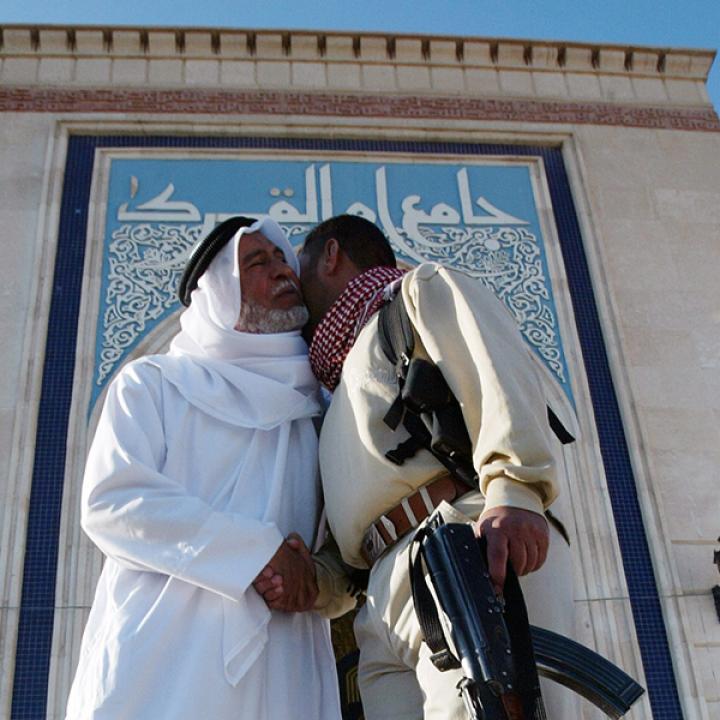
- Policy Analysis
- Articles & Op-Eds
Iraq: Are Shia Leaders Ready for Sectarian Healing?

Recent trips to Iraq indicate that the struggle against the Islamic State has rekindled the possibility of sectarian cooperation.
It is often assumed that the rise of the so-called Islamic State of Iraq and the Levant (ISIL, also known as ISIS) group since 2013 has made sectarian reconciliation harder to achieve in Iraq. Many of Iraq's Sunnis were swept up in the ISIL military campaign: in some cases they turned on Shia soldiers and civilians from their own districts and villages. In the worst single incident, ISIL worked with local Sunni tribes to murder 1,566 Shia Iraqi Air Force cadets near Tikrit on June 12, 2014.
Despite these terrible facts, I have found that the war against ISIL may be having the opposite effect, instead opening a window for sectarian reconciliation in the country. During recent visits to Iraq, I formed two strong impressions.
Late last year, I returned with the sense that Sunni communities were ready to work with the government in Baghdad to return some semblance of normality after the terrible experience of living under ISIL. Returning from another visit last week, where I interviewed almost all the Shia political bloc leaders, I brought back the sense that Shia leaders have recognised there is a window for reconciliation and are keen to investigate what can be achieved.
BOTTOM-UP RECONCILIATION?
Life under ISIL has shown Sunni communities what true oppression feels like. More than for any other community in Iraq, the rise of ISIL has been a disaster for the Sunnis.
Under ISIL, local Sunnis are killing their tribal and neighbourhood brethren every day. The Sunni towns and villages are being destroyed by the war and by the economic ruin wrought by isolation from the Iraqi state's payroll and services.
Tribes have turned inwards upon themselves. As one Sunni religious interlocutor explained: "There are Sunni tribes who hate their own brothers more than the Shia now, and who want to use the Hashd al-Shaabi [Popular Mobilisation Units] for revenge and for power."
Above all else, these affected Sunnis want to return to their homes, to live in peace, and to be protected and helped in reconstruction through partnership with a government in Baghdad. The widespread psychological shock of ISIL occupation is a potential reset button in sectarian relations.
Local-level cooperation against ISIL has been widespread, spanning across sectarian lines. In the clearance of ISIL presence, there has been significant Sunni tribal cooperation with the Hashd al-Shaabi. Like their Shia counterparts, the local Sunni military resistance against ISIL feel they have earned a long-term role in politics.
Local administrators -- the provincial governors, district administrators and sub-district mudiyars -- have likewise worked with government and Hashd al-Shaabi partners. Indeed a senior Hashd al-Shaabi figure told me: "It is harder to reconcile with the Sunni leadership than the Sunni people."
This is the wellspring of the idea of "community reconciliation" to which Shia leaders increasingly refer. But the experience of the "surge" in 2007-2008 is that bottom-up reconciliation can work, but not forever. There needs to be an overarching national reconciliation framework promising conferences, constitutional and legal amendments, and guarantees. This is vital in cementing gains and reducing the disruptive effect that Iraqi politicians and their media outlets can have on reconciliation.
WILL PAN-SHIA ALLIANCE SIGN ON?
From what I heard in Baghdad in March 2016, the pan-Shia mega bloc has detected the change in Sunni sentiment and wants to investigate. The Shia leaders are tired of war but now feel secure enough to negotiate. As one Shia cabinet member related: "There is a change in street-level Sunni sentiment. The Shia are curious about it."
Some of the National Alliance's leaders are plainly ambitious and envisage the Iraqi Sunnis as potential political partners in an era of post-sectarian politics. As one Shia leader noted, "no matter how many Shia there are," the Shia would never be allowed to rule Iraq effectively as long as the only option was an ineffective, all-inclusive unity government. To his mind, and to at least one other Shia bloc leader, a cross-sectarian majority government staffed by Shia and Sunni leaders was the only way forward.
The Shia may also be looking forward to a post-Kurdish Iraq, in which Sunnis represent a larger portion of the country's population. Talks are likely to begin tentatively this year on a form of negotiated long-term separation between the federal and Kurdish parts of Iraq, and the Shia are very focused on avoiding the formation of further ethno-sectarian regional governments in the Sunni areas or Basra. This has driven Shia leaders to consider how a better deal could be crafted for the Sunnis using existing provincial powers legislation.
There are still many problems between communities in Iraq -- there is no sense in understating the scale of the generational challenge ahead. But there are potential openings as well as obstacles.
One such opening is that the struggle against ISIL has rekindled communal ties between sectarian communities. An optimistic bloc leader explained that hundreds of thousands of Sunni refugees have lived in predominately Shia areas such as Karbala for the past year and a half, their children going to school with Shia families, with no security problems. This has reopened the people's eyes to each other in a way that has been rarer and rarer since 2003 but which could now offer hope for the future.
Michael Knights is a Lafer Fellow with The Washington Institute.
Al Jazeera



